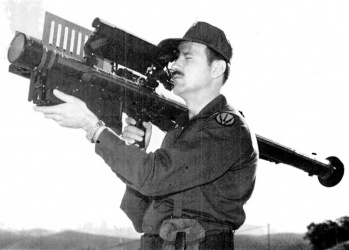Difference between revisions of "FIM-92 Stinger"
Colok76286 (talk | contribs) (→External links: Added References) |
Colok76286 (talk | contribs) (→External links: Added link to Wikipedia article) |
||
| Line 122: | Line 122: | ||
* ''topic on the official game forum;'' | * ''topic on the official game forum;'' | ||
* ''other literature.'' --> | * ''other literature.'' --> | ||
| + | |||
| + | * [[wikipedia:FIM-92_Stinger|[Wikipedia] FIM-92 Stinger]] | ||
=== References === | === References === | ||
Revision as of 07:37, 22 September 2022
Contents
Description
The FIM-92 Stinger is an American infrared homing surface-to-air missile. It exists in two variants: FIM-92E and FIM-92K, and was introduced in Update "Wind of Change". It is also known as the "Fliegerfaust 2 Stinger" in German service.
Vehicles equipped with this weapon
General info
| FIM-92E characteristics | |
|---|---|
| Calibre | 70 mm |
| Mass | 10.1 kg |
| Guidance | IR |
| ECCM | Yes |
| Aspect | All-Aspects |
| Lock range in rear-aspect | 6 km |
| Lock range in all-aspects | 6 km |
| Maximum speed | 1,000 m/s |
| Maximum overload | 10 G |
| Missile guidance time | 15 secs |
| Explosive mass | 540 g TNTeq |
| Fuze delay | 1 m |
| Fuze Sensitivity | 0.1 mm |
| FIM-92K characteristics | |
|---|---|
| Calibre | 70 mm |
| Mass | 10.1 kg |
| Guidance | IR |
| ECCM | Yes |
| Aspect | All-Aspects |
| Lock range in rear-aspect | 6 km |
| Lock range in all-aspects | 6 km |
| Maximum speed | 1,000 m/s |
| Maximum overload | 10 G |
| Missile guidance time | 15 secs |
| Explosive mass | 540 g TNTeq |
| Fuze delay | 1 m |
| Fuze Sensitivity | 0.1 mm |
| Trigger Radius | 1 m |
Effective damage
Describe the type of damage produced by this type of missile (high explosive, splash damage, etc)
Comparison with analogues
Give a comparative description of missiles that have firepower equal to this weapon.
Usage in battles
Describe situations when you would utilise this missile in-game (vehicle, pillbox, base, etc)
Pros and cons
Summarise and briefly evaluate the weaponry in terms of its characteristics and combat effectiveness. Mark pros and cons as a list.
Pros:
- Fire-and-forget
- IRCCM makes it resistant to flares
- K variant has proximity fuse
Cons:
- Low overload of 10 G only
- 6 km range is outranged by some AGMs
History
Stinger Development
In the 1960s, the US military's standard man-portable air-defense system (MANPADS) was the FIM-43 Redeye, a missile launcher developed by Convair/Ponoma. However, the Redeye missiles were deemed to be too slow, unmanoeuverable, and could not distinguish its target source well enough to be an effective anti-aircraft weapon.[1] A program for an improved missile was launched in 1967, titled Redeye II. This new missile program was part of the Advanced Sensor Development Program, which sought to give the man-portable missile an all-aspect seeking capability. By 1971, Redeye II was chosen as the next standard MANPADS missile, and was given the designation FIM-92. The name of the program was eventually changed in March 1972 into the Stinger.[2]
The contract to develop the missiles went to General Dynamics in June 1972.[1] The first tests with the missiles began in November 1973, though technical problems caused delays that the first missile was only fired shoulder-launched in 1975.[2] The Stinger Production Qualification Test-Government (PQT-G) began in April 1976.[3] The PQT-G concluded in 1977, and resulted in a mass production contract in April 1978 for General Dynamics to produce the FIM-92A Stinger missiles. The missiles reached the US military, where the Stinger missiles reached IOC (Initial Operational Capability) status in February 1981, resulting in the Stinger's steady replacement of all other MANPADS in service. The basic model, the FIM-92A, featured a cooled conical-scan IR seeker that allowed all-aspect acquisition and homing abilities as well as a AN/PPX-1 Identification, Friend or Foe (IFF) system.[1]
Improvements into the FIM-92 stingers led to succeeding variants. The FIM-92B started development in 1977. It is also known as Stinger-POST (Passive Optical Seeker Technique) and featured an improved IR/UV seeker to better distinguish countermeasures. The next version, the FIM-92C began development in 1984 and was named as Stinger-RMP (Reprogrammable MicroProcessor). Introducing a new microprocessor that was reprogrammable, the Stinger-RMP allowed the Stinger platform to adapt to new threats and countermeasures without requiring a new missile design. The Stinger-RMP became the basis of the succeeding FIM-92D to G variants, which featured various improvements on the Stinger-RMP capabilities.[1]
Media
Excellent additions to the article would be video guides, screenshots from the game, and photos.
See also
- ATAS (AIM-92) - Helicopter-borne variant of the Stinger
External links
References
- Citations
- Bibliography
- Army Technology. "Stinger Man-Portable Air Defence System (MANPADS)." Army Technology, Verdict Media Limited, Website. Accessed 07 Apr. 2021 (Web Archive).
- Parsch, Andreas. "FIM-92" Designation Systems, 14 Feb. 2005, Website. Accessed 07 Apr. 2021 (Web Archive).
- Pike, John; Sherman, Robert. "FIM-92A Stinger Weapons System: RMP & Basic." Federation of American Scientists - Military Analysis Network, 09 Aug. 2000, Website. Accessed 07 Apr. 2021 (Web Archive).




